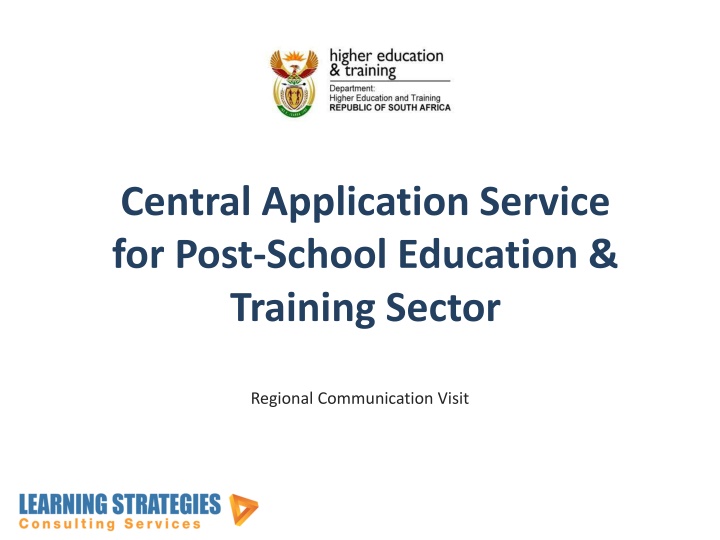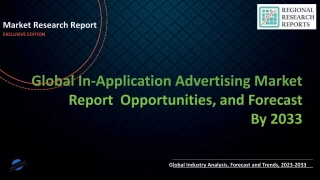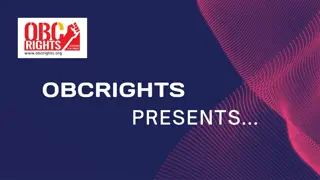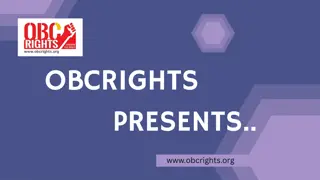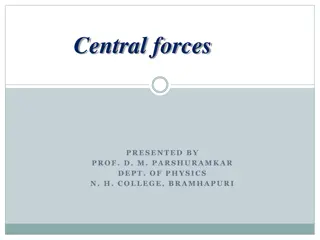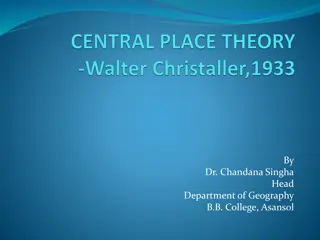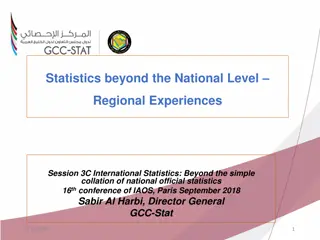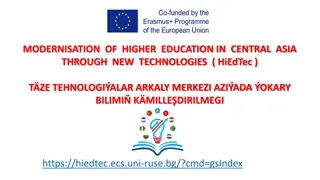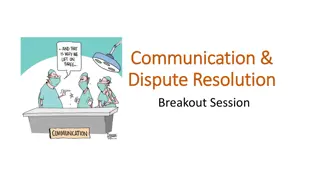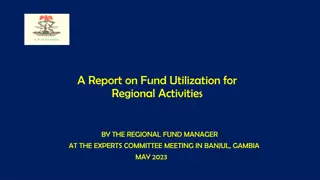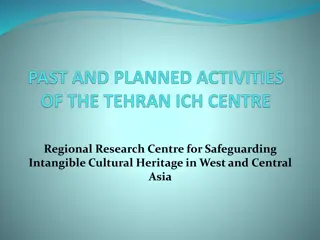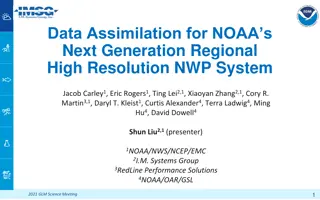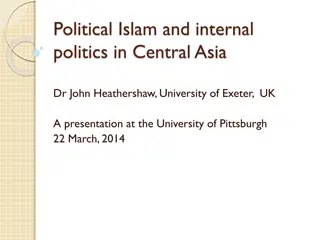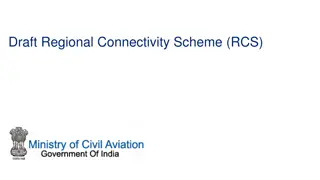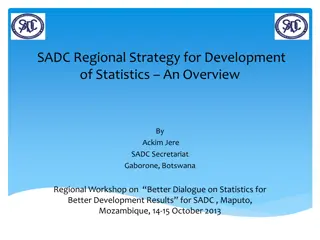Central Application Service for Post-School Education - Regional Communication Visit
This content provides an overview of the agenda for a regional communication visit focusing on the Central Application Service for Post-School Education and Training Sector. It includes details on confirmed meeting objectives, review of the enterprise architecture, legislative processes, implementation plan, financial model, and more.
Download Presentation

Please find below an Image/Link to download the presentation.
The content on the website is provided AS IS for your information and personal use only. It may not be sold, licensed, or shared on other websites without obtaining consent from the author.If you encounter any issues during the download, it is possible that the publisher has removed the file from their server.
You are allowed to download the files provided on this website for personal or commercial use, subject to the condition that they are used lawfully. All files are the property of their respective owners.
The content on the website is provided AS IS for your information and personal use only. It may not be sold, licensed, or shared on other websites without obtaining consent from the author.
E N D
Presentation Transcript
Central Application Service for Post-School Education & Training Sector Regional Communication Visit
WELCOME & APOLOGIES 2025/02/15 2
Agenda 1. 2. 3. Opening Welcome & Apologies Confirm Meeting Objectives Review of Consolidated CAS Enterprise Architecture 1. Detailed review of CAS Enterprise Architecture deliverable 1. Chapter 1 Overview 2. Chapter 2 Service Model 3. Chapter 3 Governance 4. Chapter 4 Standard Operating Procedures 5. Chapter 5 ICT Architecture 6. Chapter 6 Human Resource Management 7. Chapter 7 Advocacy & Communication 8. Chapter 8 Stakeholder Engagement 9. Chapter 9 Monitoring & Evaluation 2. Legislative Process for enacting CAS 3. Review of CAS Implementation Plan and Financial Model 1. Chapter 10 Implementation Plan 2. Chapter 11 Financial Model 3. Key Recommendations Lunch Discussion Sessions 1. Standardisation Process 2. Application Form and Statuses Way Forward 15 min 5 min 120 min 75 min 15 min 30 min 4. 5. 45 min 105 min 6. 15 min 2025/02/15 3
CONFIRM OBJECTIVES 2025/02/15 4
Confirm Objectives Provide an Overview of the CAS Enterprise Architecture Enable questions by participants Enable raising of comments and issues by participants Address comments, questions and issues where possible Gather Input on key topics Agree Way Forward and obtain nominations to user groups To cover the Agenda we have to implement strict time-keeping on reviewing the detail of the Enterprise Architecture deliverables 2025/02/15 5
REVIEW OF CONSOLIDATED CAS ENTERPRISE ARCHITECTURE 2025/02/15 6
Overview of Enterprise Architecture project Enterprise Architecture translates the concept or vision for a future business or organisation into a design document that defines how the business should operate, be structured and supported with technology and processes 1. 1. Implementation Consolidated Enterprise PMO Project Management & QA 3. Plan 5. ICT 6. 10. 4. Architecture Gover nance HRM SOPs 12. 2. Service Model Enterprise Architecture Review 8. 11. Cost Estimates 9. 7. Stakeholder Management Monitoring & Evaluation Advocacy 2025/02/15 7
The CAS Concept Applicants Central Application Service PSET Institutions Admit Apply Facilitate Online Applications CAS Process Offline Applications Walk-in applications Investigate opportunities Prepare application Submit application Change application Provide additional information Consider and accept offers Prepare application cycles Capture off-line applications Check applications Submit application Communicate with applicants Resolve applicant queries Refer regretted applicants Prepare programme data Receive applications Request additional information Update application status Select and make offers Register and admit students 2025/02/15 8
Consolidated CAS Enterprise Architecture chapters Chapter 0 Executive Summary (including Recommendations) Chapter 1 Overview of Consolidated CAS Enterprise Architecture Chapter 2 Service Model Chapter 3 Governance & Management Report Chapter 4 Standard Operating Procedures Chapter 5 ICT Architecture & Infrastructure Chapter 6 Human Resource Management Chapter 7 Advocacy & Communication Strategy Chapter 8 Stakeholder Engagement Strategy Chapter 9 Monitoring & Evaluation Framework & Policy Chapter 10 Implementation Plan Chapter 11 Financial Model Vol 1 Vol 2 Vol 3 Vol 4 2025/02/15 9
Input to CAS Enterprise Architecture Direct Engagements Represented at CAS Governance Forums Higher Education South Africa (HESA) Department of Basic Education (DBE) Universities - Registrar WITS DHET - TVET Colleges Universities - Registrar UJ DHET - SETAs Universities Registrar Unisa National Career Advice Portal (NCAP) DHET - Community Colleges National Skills Fund (NSF) DHET VCET Branch South African College Principals' Organisation SETA CEO Forum Study Tour - UCAS Study Tour Ireland CAO KZN CAO National Student Financial Aid Scheme (NSFAS) Department of Labour (DoL) Public Services Commission PwC Higher Education Conference ITS User Group 2025/02/15 10
CAS Enterprise Architecture validation Registrar Forum Service Working Group Technical Working Group Advisory Committee Steering Committee July 2015 28 July 7 July 9 July 16 July 30 July Nov 2015 4 November March 2016 2 March 3 March 10 March 6 April The CAS Enterprise Architecture was submitted to the Minister in March 2016 and was approved by the Minister on 31 March 2016 The CAS Enterprise Architecture has been published on the DHET website at http://www.dhet.gov.za/SitePages/OrgUniversities.aspx 2025/02/15 11
Levels of Engagement Time to Launch Level of Engagement to Date Review of application forms Engagements at Registrar levels and selected Admissions offices Communication to Admission Officers (ITS) and IT Ecexs (ASAUDIT) Universities 2-4 yrs TVET Colleges Involvement at Working Group levels 4 yrs Community Colleges Involvement at Working Group level 5 yrs Involvement at Working Group level Presentation to SETA CEO s SETA s 6 yrs While the level of engagement at Universities has been higher than other Institution types, the Time to Launch is further away for these Institutions 2025/02/15 12
Chapter 2 Service Model (already approved) 1 2 3 4 5 6 7 8 9 10 CAS Application Handling Flow 11 CAS Application Pricing Model 12 CAS Central Academic Programme Database 13 Institutional Mechanisms and Entity Options 14 Conclusion APPENDICES A. CAS Analysis Report B. CAS Comparison Report C. CAS Environmental Scan Report D. Stakeholder Inputs Report E. Current University and Technical University Application Form Analysis Terms of Reference Introduction Key Service Model Principles Stakeholder Expectations Service Operating Model Service Model Dimensions Generic High Level Service Model CAS Integration with Related Entities Application Service Target Market 2025/02/15 13
Chapter 2 Service Model Term Definitions Term Definition A learning programme leading to a certified PSET qualification offered by an academic institution at a specific campus (if offered at multiple campuses by the institution) Academic Programme Applicant An individual who wishes to apply for an Academic Programme Application A formal request by an applicant to be considered for one or more Academic Programmes A period during which Applications can be submitted. Note that multiple Application Cycles may be open at any one point (e.g. Annual, Semester, Quarter) Application Cycle Application Submitted The point at which an Application is finalized by the Applicant The point at which all the Academic Programmes applied for on an Application have been considered by the relevant institutions Application Completed Application Closed The point at which an Application Cycle is closed and applications are no longer considered Where an Application and Applicant that shows poor chance of success or has been regretted is referred for guidance to determine alternative selections Application Referral Direct Application An application made directly to the Institution, by-passing the CAS system An application made at the Institution, resulting in an immediate selection decision or immediate registration Walk-in Application An Application that is not captured online by the Applicant, but is rather mailed in paper form or emailed as an attachment to the CAS, and which, on receipt by the CAS, is subsequently captured online by CAS staff Offline Application 2025/02/15 14
Chapter 2 Service Model Target Market All entering undergraduates - applications for entering undergraduates into Post School Education and Training to Academic Programmes leading to NQF-approved qualifications from PSET institutions that the applicant has not previously attended. Applications will be for Academic Programmes as specified by individual institutions - Institutions can enrol or admit at a more detailed level. Target market specifically excludes: Returning students and re-commencement of previously registered Academic Programmes Post graduate students Unregistered courses and short courses not linked to NQF Academic Programmes that do not lead to NQF-approved qualifications; Transfers between institutions Conversion to another course within same institution 2025/02/15 15
Chapter 2 Service Model Stakeholder Expectations Government: DHET Institutions Applicants Improve access to PSET opportunities Retain admissions autonomy Simplicity Ease of access Information for Planning and Steering To select appropriate applicants One application Academic Advice Visibility of application data Simplicity Low cost Real time information Access to PSET opportunities Applicants HEMIS data requirements Accurate Complete Residential housing application Meets requirements Efficient allocation of funding to students Funding available to students Access to funding (NSFAS and other) Funding Avoidance of duplicate funding Selection of students with funding Early assessment of eligibility and, where possible, commitment to funding Access to funding status and process 2025/02/15 16
Chapter 2 Service Model Principles Policy and legislative matters are the responsibility of the DHET inter-branch steering committee DHET should be responsible for ensuring the appropriate compliance with the implementation of the CAS Participation should be compulsory for all applications (not voluntary participation by institutions) Focus is strictly applications handling, not admissions Target market is entering undergraduates into PSET (refer detail below) A single point for information and access into the PSET, similar to CACH The final objective is one application, one fee with an affordable application fee where the one application could be to multiple institutions and/or programmes, covering also o Integrated application for Study, Learnerships, Apprenticeships, Scholarships, Student housing and Funding o Funding from Both NSFAS and other sources including funding from institutions 2025/02/15 17
Chapter 2 Service Model Principles Visibility of selection and offering by institution Accommodate full cycle service from application through status changes to confirmed offer and acceptance Resolve or substantially address the multiple acceptances and registration uncertainty A single database of all applications and applicants Seamless transfer of data between CAS, institutions (both educational and funding institutions) and applicants Receive feedback data of walk-in students especially/specifically at skills centres and community colleges to close the loop , but also from any other Institutions where walk-in applications are recorded Once an institution selects a student, communication should be directly between institution and applicant with CAS assistance if required The CAS should be self-funding 2025/02/15 18
Chapter 2 Service Model Operating Model Clearing House & Application Closing Reporting Monitoring & Evaluation Interface with Institutions Academic Programme Definition Outreach & Training NSFAS Funding Integration Policy & Legislation Application Handling CDS/NCAP integration Two-way Communication with Applicants Application Handling Receive & Process Supporting Docs Receive & Process Change of Mind Receive & Match Application Fee Receive & Process Application Interface with Institutions Receive Data from Institutions Online Applications Portal Send Data to Institutions 2025/02/15 19
Chapter 2 Service Model Service Partners DBE DAFF DoD Department of Higher Education and Training Policy & Legislation DoH National Public Entity Central Application Service DoL A p p l i c a n t s Universities Board Interface & integration SETAs Central Application Service TVETs Community Colleges Private Colleges Contact Centre Outreach and Distribution Outreach and Distribution Outreach and Distribution Career Development Programme Definition Application Handling NSFAS Outreach & Training Cloud Based Hosted Central Database NSF Clearing House Other Funders Qualifications & Programmes Reporting & Monitoring NLRD/SAQA DHET Regional Offices Dept of Home Affairs 2016-03-01 SARS DBE IEB 21 NGOs CIE 2025/02/15 20
Chapter 2 Service Application Handling Com Com Com Mailed App & Add Docs/CoM Scan App & Add Docs OCR / Capture App & Add Docs QA & Screen Viability of App Emailed Apps & Add Docs/CoM Submit App Funding Eligible? Confirm/Waive Payment Online App & Add Docs/CoM Walk-in/Call for assistance/CoM Call Centre / Assisted App Walk-in Application Natl ID NSFAS Eligible Service Easypay / Bank / Card DBE/ IEB SAQA NLRD 2025/02/15 21
Chapter 2 Service Model Application Handling Programme Application Application Withdrawn Pending Offer Regret Offer Withdrawn Offer Declined Offer Taken Up Offer Cancelled 2025/02/15 22
Chapter 2 Service Model Multiple Offers Option 1: Visibility this option involved simply providing visibility of the various applications made by an applicant so that institutions can see the multiple applications and in fact the multiple offers and acceptances Option 2: Order of Preference this option involves assessing each application in order of preference meaning that the first priority application would be submitted to that institution first and only after that institution has dealt with that application and not made an offer would the application be forwarded to the second institution Option 3: One Acceptance Allowed this option simply involves implementing a rule that an applicant may only accept one offer, meaning that on acceptance, all other offers will effectively be rejected Option 4: Offers with Expiry Dates under this option, institutions would have the option to place expiry dates on their offers requiring applicants to take up their offer or face the offer expiring at a point in time. Registrar s Forum recommended combination of Option 1 and Option 4 2025/02/15 23
Chapter 2 Service Model Application Fees A single fee should be charged for one or more applications A higher fee should be charged for non-SADC applications A fee should be charged for change of mind after allowing at least one fee change of mind No fee should be charged where an applicant is referred to an alternative opportunity Applicants should be incentivised to submit online applications, but not necessarily through reduced application fee Pricing Model recommended by Registrar s Forum in July 2015 Position Paper on No Fee option developed 2025/02/15 24
Chapter 2 Service Model Institutional Mechanism Option 2C approved by the Minister of Higher Education and Training 2025/02/15 25
Benefits to the PSET Sector Universities TVET Colleges Community Colleges SETA s DHET Improved access to PSET opportunities Improved access to PSET funding Improved allocation of PSET places and funding Information available during application cycle Information to assist Planning and Policy Consistent application process and easier / more cost-effective for applicants to apply to multiple Institutions Control and autonomy over selection and admission process (less applicable to Community Colleges) Access to nation-wide group of applicants Opportunity to streamline internal processes Visibility of multiple acceptances to reduce no-show at registration (not applicable to Community Colleges) Early access to offer alternate options to applicants with all applications regretted Mechanism to register/select applicants without investing in own systems Early access to offer alternate options to applicants with little chance of success 2025/02/15 26
Chapter 3 Governance and Management Report 1 2 3 4 5 6 7 8 9 10 Board Committees 11 Advisory Structures 12 Management of the CAS 13 Conclusion APPENDICES A Central Application Service Policy Framework B - Draft Central Application Services Bill C Delegation of Authority D Executive Committee - Terms of Reference E Audit and Risk Committee - Terms of Reference F Human Resources and Remuneration Committee Terms of Reference Terms of Reference Legislative Environment Policy Environment Governance Model for the CAS CAS Policy Framework CAS Entity Structure and Enabling Legislation Roles and responsibilities of Key Stakeholders Executive Authority Board of CAS 2025/02/15 27
Chapter 3 Governance Entity Structure Public entity established through enabling legislation Autonomous from department Has a governing Board Mandate derived from Act establishing the public entity Funded by Parliament via the department, as well as own funds PFMA is applicable Board is the Accounting Authority Own policies for HR, SCM, remuneration etc. 2025/02/15 28
Chapter 3 Governance Board Two executive Board members - the Chief Executive Officer and Chief Financial Officer of the CAS Thirteen non-executive Board members appointed by the Minister of Education and Training ensuring effective representation across the PSET sector. These should include at least: Four from universities Two from TVET colleges Two from the SETAs and skills sector One from community colleges Three other non-executive Board members with experience and involvement from across the PSET sector One Ministerial appointment The Chairman of the Board should be elected from the non- executive members 2025/02/15 29
Chapter 3 Governance - Committees Board Committees An Executive Committee comprising at least the CEO, CFO, Chairperson and Deputy Chairperson of the Board An Audit and Risk Committee should be established in terms of the Treasury guidelines regarding the formation of audit committees as provided in terms of section 77 of the PFMA A Human Resources and Remuneration Committee, again, comprising a maximum of three members of the Board and at least two other non-board members, including the executive Head of Human Resources Stakeholder Groups Sector Advisory Committees User Groups 2025/02/15 30
Chapter 3 Governance Roles and Responsibilities - DHET Policy and legislative matters supporting the establishment and operations of the CAS Creation of an inter-branch Policy Committee out of the CAS Steering Committee after the CAS is formally established to advise on all policy matters Ensuring all the necessary policy and legislative structures are in place to ensure compliance with the implementation and operating requirements of the CAS 2025/02/15 31
Chapter 3 Governance Roles and Responsibilities - CAS Centralised Services Application handling factory (Receiving, processing) Payment processing and reconciliation Database management and integration Clearing house Career counselling Refer applicants that are unsuccessful to other institutions / opportunities Monitoring and evaluation Distributed services Outreach Career fairs, school visits etc. Support for career and education advice Promotion Apply Now Targeted activations Promoting advise on courses and opportunities available in the PSET system Training Distribution 2025/02/15 32
Chapter 3 Governance Roles and Responsibilities Service Partners Define all programmes offered and submit information relating to programmes to the CAS so that applications can be submitted against these offerings Receive application data from the CAS relating to all applications made to that institution Select students based on applications received and communicate with both students and the CAS relating to the decisions in regard to the selection of students Provision of any additional information including final registration of students which will assist in completing the data set enabling effective planning and sector management Adhere to sector-agreed milestones and cut-off dates to ensure that selection process is timeous and efficient 2025/02/15 33
Chapter 4 Standard Operating Procedures 1 2 3 3.1 Business Architecture 3.2 Stakeholder Map 4 Standard Operating Procedures 4.1 Preamble 4.2 Core Application Handling 4.3 Central Academic Programme Data Store Process Flow 4.4 Supporting Functions Process Maps 4.5 Outreach & Promotion Protocol 4.6 Training Protocol 4.7 Communication Protocol 4.8 Call Centre Scripts 5 Conclusion A. Core Application Handling Process Maps B. Central Academic Programme Data Store Process Flow C. Finance Management Process Maps D. Supply Chain Management Process Maps Terms of Reference CAS Service Operating Model CAS Functional Model 2025/02/15 34
Chapter 4 SOPs Business Architecture Applicant Facing Offline Applications Planning and Monitoring & Evaluation Call Centre Academic Programme Information Online Applications IT Support & Business Intelligence Human Resource Management Outreach & Promotion Supply Chain Management Application Handling Finance Management Communication Application Referrals & Clearing House Application QA Payment Processing & Reconciliation Training Institution Integration Support Institution Front End Institution Integration Core functions Support functions Institution Facing Generic Process Maps Process Maps Protocols Scripts Policies Process Flow 2025/02/15 35
Chapter 4 SOPs Core Business Process Level 1 2025/02/15 36
Chapter 4 SOPs Outreach and Promotion Protocol The objectives of the Outreach and Promotion Protocol is to ensure that awareness of the CAS in created, maintained and enhanced Outreach and Promotion Managers are responsible to plan and forecast outreach visits and handbook printing once a year and monitor and manage adherence on an ongoing basis Outreach and Promotion Schedule: Initiative Frequency Handbook distribution to all schools January every year Handbook distribution to all participating institutions January every year Handbook distribution to points of presence January every year Institution Open Days 100% of all Career Fair attendance 50% off all (rotate) School visits 25% off schools not covered above (rotate) Radio interviews Once a month Promotion pamphlets All school notice boards Social Media Ongoing 2025/02/15 37
Chapter 4 SOPs CAS Training Protocol The objectives of the Training Protocol is to ensure that individuals responsible for supporting the CAS Operations and Institutions using the CAS application are adequately skilled The training areas covered by the Training Protocol include the CAS System and all supporting processes, policies and protocols Training will be conducted at a regional central training venue All training interventions will be evaluated through knowledge testing and reviewed by Training Supervisors Audience, Type and Frequency: Training Population Induction Refresher Super Users Every 2nd year CAS Employees Quarterly (seasonal) Every year Every 2nd year Institutional Users Half yearly Every year Call Centre Agents Monthly (seasonal) Every year Half yearly Outreach and Promotion Quarterly (seasonal) Every year Every year Clearing House Agents Yearly (seasonal) Every year Every year 2025/02/15 38
Chapter 4 SOPs Communication Protocol The objective of the Communication Protocol is to ensure that an applicant in the CAS system is always aware of the status of his/her application Methods of communication utilised include: Online access to the CAS system IVR (Interactive Voice Response) Push SMS Call Centre Walk-in Centres Post Communication is triggered by changes in the process flow The key principle is to use communication methods with the least cost for the purpose of the communication The communication responsibility of the CAS is limited to CAS operations, e.g. receiving applications to release to institutions as well as referral and clearing house activities All communication between the institutions and the applicant from when released to the institution till notification of final acceptance or rejection is the responsibility of the institution (institutions can opt to delegate this responsibility to the CAS on a Service Level Agreement) 2025/02/15 39
Chapter 4 SOPs Communication Protocol Communication Message CAS Responsibility Initial comms Follow-up comms Application submission < 1 Bus Day N/A Application payment < 1 Bus Day N/A Application submitted but not paid < 1 Bus Day Weekly Application submitted with missing supporting docs < 1 Bus Day Weekly Application released to institution < 1 Bus Day N/A Feedback on application from Institution (if done by CAS) < 1 Bus Day N/A Referral for counseling < 1 Bus Day N/A Opt-In for Submission to Clearing House < 1 Bus Day Weekly Feedback on Clearing House Submission < 1 Bus Day N/A Application closed < 1 Bus Day N/A Note: Follow-up communications will stop after a pre-defined timeframe if no response from applicant recorded 2025/02/15 40
Chapter 4 SOPs Call Centre Call Centre will be used to manage Incoming Calls from applicants and other parties, and Outgoing Calls to applicants when no other communication mechanism is available IVR technology will be used to handle routine calls for information requests, with options to talk to an agent 2025/02/15 41
Chapter 4 SOPs Call Centre Scripts Incoming Call Establish identity Establish requirement Resolution /Refer Call taking Close call Nature of Call Potential Outcome IVR Application query Answer query Application completion assistance Talk applicant through completion Application completion Complete application form Application status follow-up Status look-up and feedback Yes Career guidance Refer to on to CDS Payment query Status look-up and feedback Yes Funding query Refer to NSFAS/other funding institution Selection query Refer to Institution Yes Accommodation query Refer to Institution Change of mind request Process change of mind request Cancellation request Process cancellation request Application form request Mail application form Access or technical query Transfer to technical department Academic Programme Catalogue request Email or post Academic Programme Catalogue 2025/02/15 42
Chapter 4 SOPs Call Centre Scripts Outgoing Call Purpose explanation Confirm understanding Introduction Close call Purpose of Call Key message Status feedback Latest status change Outstanding payment follow-up Request proof of payment Selection feedback Inform of selection Close-out feedback Inform applicant of close-out Outstanding documentation follow-up Request outstanding documentation Application status change Inform applicant of status change Referral for counseling Provide counseling contact info Note: where possible other communication mechanisms will be used in preference to Outgoing Calls 2025/02/15 43
Chapter 5 ICT Architecture and Infrastructure 1 2 3 3.1 Architectural Overview 3.2 Design Principles 3.3 Application Architecture 3.4 Integration Architecture 3.5 Business Applications 3.6 Technology Components in KZN CAO 3.7 Technology Components in NSFAS 4 CAS ICT Infrastructure 5 Conclusion Terms of Reference PSET IT Landscape Assessment CAS Application and Integration Architecture 2025/02/15 44
Chapter 5 ICT Architecture Design Principles Comprehensive programme information on central programme database Regarding the programme Regarding the Institution offering the programme Making clear the minimum entrance requirements Making clear the costs of the programme Standardised terminology, status and conditions Clearly defined Easily understood by Applicants Consistent across PSET Online applications via PC and mobile devices Unique identification of applicant and application 2025/02/15 45
Chapter 5 ICT Architecture CAS Application / Integration Architecture Institution F/E Mobile F/E CAS F/E Web F/E CAS Finance & SCM HR & Payroll CAS Finance Contact Centre Content Manager Application & Workflow Engine Reporting platform SMS/Email Service User Directory Scanning System Document Manager Programme DB Integration Layer Home Affairs ITS Old CACH Easypay CDS DBE NSFAS Open W/serv People soft NCAP IEB NSF SARS Pay@ Career Sites Other Funding Bank CIE Flat File SETA Systems SAQA NLRD Coltech 2025/02/15 46
Chapter 5 ICT Architecture CAS Application / Integration Architecture - 2 CAS Application & Workflow Engine The CAS Application & Workflow Engine is the core of the ICT Architecture It will contain the core business logic and workflow paths, and must be configurable to allow flexibility in business rules and wokflow rules It includes the CAS databases. The CAS engine must be hosted centrally and accessible through standard internet protocols. CAS Programme Database The CAS Programme Database houses the programme information against which applicants will make programme information and selection decisions It will contain all programme information enabling information and selection It will be maintained by the Institutions participating in the CAS It is recommended that the CAS is the host of the central National Programme Database(s) 2025/02/15 47
Chapter 5 ICT Architecture CAS Application / Integration Architecture - 3 Front Ends (F/E) The CAS Engine is made available to end users through multiple Front Ends, including Web Front End consisting of a CAS public website containing information and content available to the general public, and an applicant portal that will be used by Applicants for processing and monitoring applications (and whose access will be restricted to only their data) Mobile Front End that provides an alternative, mobile-friendly mechanism for Applicants and other outside, non-privileged users CAS Front End that provides the functionality for CAS employees, with access and functionality appropriate to their job function and level of authority. Typically CAS employees will have access to the data of a range of applicants Institution Front End that provides the functionality for institution employees, with access and functionality appropriate to their job function and level of authority, and with access restricted to applicants to their institution. Institution Front Ends may be differentiated for Educational Institutions, Funding Institutions, Companies and Programme Database Institutions 2025/02/15 48
On-line Applications - 2016 # of Total Total Online Paper % Online Paper % institutions Applications Registrations 9 1,388 0.7% 198,332 99.3% 199,720 1% 71,117 55.3% 57,558 44.7% 128,675 55% Universities not offering on-line apps 4 100,742 34.4% 191,781 65.6% 292,523 34% 53,301 67.9% 25,210 32.1% 78,511 68% KZN institutions via CAO 13 595,585 75.6% 192,285 24.4% 787,870 76% 485,819 85.6% 82,049 14.4% 567,868 86% Universities offering On-line Applications 26 697,715 54.5% 582,398 45.5% 1,280,113 610,237 78.7% 164,817 21.3% 775,054 Total There is a significant trend towards on-line applications. In total 54,5 % of applications were already on-line for 2016 75,6% of applications were on-line to institutions offering this channel An even higher percentage of on-line registrations was noted but this may be skewed by on-line access provided at institutions during registration. In total, 78,7% of registrations were on-line 2025/02/15 49
Chapter 5 ICT Architecture CAS Application / Integration Architecture - 4 CAS Supporting Applications The CAS Supporting Application provide peripheral functionality used by the core engine, and including Content Manager to enable content required by the CAS Application and the Front Ends to be stored and maintained Scanning Functionality to enable documents received by the CAS in paper format to be scanned and the stored in the Document Manager Document Manager to manage the documents received with applications, either from the Scanning Functionality, or with the online application system (Web F/E and Mobile F/E) or submitted in digital form via email or other form. The Document Manager will need functionality to transform documents to a common format (expected to be PDF) and to split submitted PDFs into multiple documents. CAS Finance to manage the financial transaction associated with applications and control that where applicants are expected to pay an application fee, this fee is received, and where application fees are funded by other entities as capitation fees, the correct reconciliation is produced to support claims for such fees. SMS/Email Service to manage the communications triggered by the application workflow User Directory to manage the user access and authentication Contact Centre functionality to enable agents to capture call information associated with an enquiry about an application or general enquiry 2025/02/15 50
